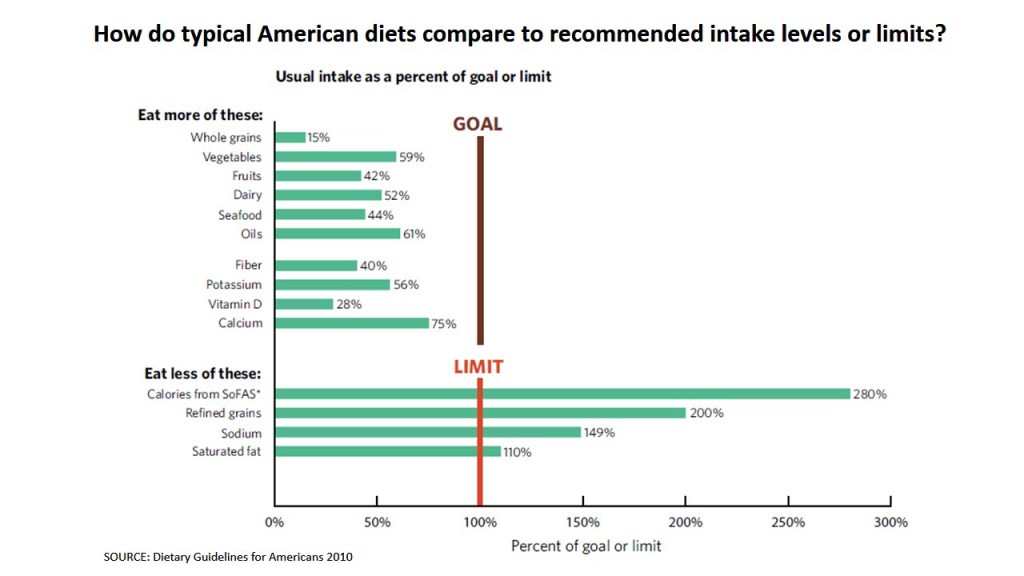A common theme in many internet posts is how the dietary guidelines are outdated, and are making people fat or sick. Common criticisms include that the guidelines . . .
- “caused the obesity and/or type 2 diabetes epidemic,”
- “are not based on scientific evidence,”
- “recommend carbohydrates/grains and they are the cause of obesity,”
- “recommend a low-fat diet, and this made people fat,”
- “made people replace fat with carbs, and they got fat.”
What’s lacking in these anti-guideline statements is good science.
A critical piece that is ignored in these claims is that most people weren’t following dietary guidelines. The figure below (from the US Dietary Guidelines for Americans – which are similar to other national guidelines) presents a good example of where things are at in the US: Americans were far from the recommendations, eating twice as much refined grains, solid fats (mainly from beef fat, butter, and shortening), and sugars, and less than 50% of the fruit or whole grains recommended (likely vegetables too, but I think that percentage may include french fried potatoes . . . ).
A paper out this week reviews 304 studies, and adds to the evidence that the Dietary Guidelines are not responsible for our health problems (Nutrition Reviews, Dec 2014), and another review published in October shows that Americans haven’t been following the Guidelines.
This point of this post is not to wholeheartedly endorse all aspects of previous and current guidelines, but to highlight the disconnect in the sweeping statements that guidelines have caused health problems. Guidelines have succumbed to industry lobbying, and may not be completely in line with current research. In fact, most dietary interventions I’ve worked on have used the guidelines for the “control” group, while the intervention group is consuming what might be considered a more “disease-protective” diet.
We are recognizing that a person’s overall dietary pattern is likely more important to their health than intakes of specific nutrients or foods, and it’s easy to lose sight of the overall picture when critiquing dietary guidelines. But overall, the main themes of the guidelines have been sound nutrition advice: including eating plenty of vegetables and fruit, choosing mostly unprocessed grains, reducing salt, fat and sugar, and getting more physical activity. The 2010 Dietary Guidelines for Americans is certainly a step in the right direction, and the recommendations for the 2015 guidelines even better.
Take home points on dietary guidelines and health:
- Guidelines can’t be blamed for current health problems, as few people have adhered to them
- Guidelines don’t recommend refined carbohydrates, low fiber grains and cereals, or high sugar items – foods that are widely overconsumed and likely contributors to obesity and chronic disease
- Data show that an increase in calories better explains the obesity epidemic than recommendations to reduce fat intake (and contrary to popular belief, Americans did not reduce their fat intake, but they did increase their calorie intake)
- Most people consume refined grains, or grains as part of desserts – which affects health much differently than whole grains, though critics tend to lump all carbs or grains in one category (somewhat like equating candy to unprocessed oats)
- Currently, the most disease-protective dietary patterns are Mediterranean, DASH (Dietary Approaches to Stop Hypertension), or patterns assigned by studies as “Prudent” “High Quality” or “Healthy Eating” – they all contain whole grains and are relatively high in carbohydrates, often demonized by dietary guidelines critics
More Reading . . .
Looking more information? The following individuals have done an excellent job presenting data in relation to dietary guidelines and health.
- Did the US Dietary Guidelines Cause the Obesity Epidemic? (Stephan Guyenet)
- No, Dietary Guidelines Are Not Making Us Sick (Colby Vorland)
- Dietitian Reijo Laatikainen has excellent slide presentation debunking the myths that the dietary guidelines are causing health problems here.
- Are Dietary Recommendations Wrong? Inconvenient Data (Kevin Klatt)
- Nutrition Recommendations Constantly Change…Don’t They? (Kevin Klatt)
